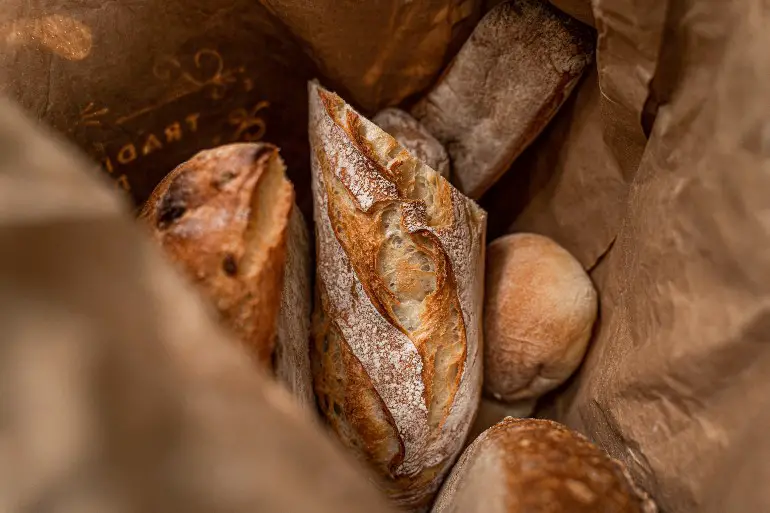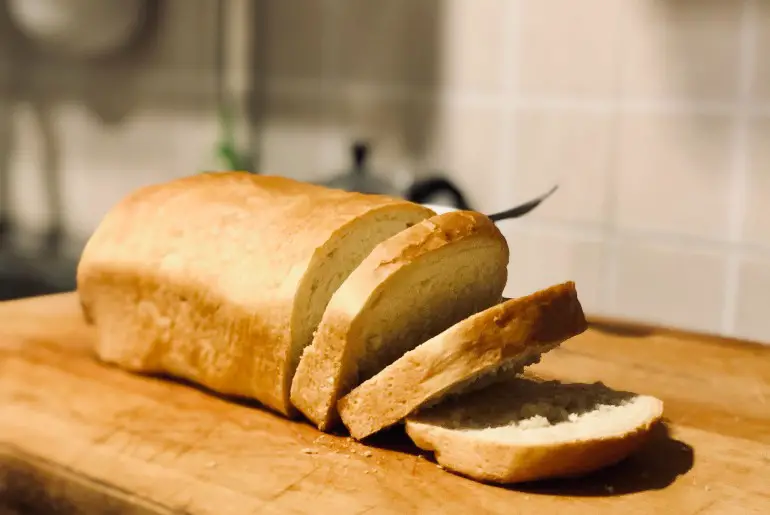Bread is a staple food for many and has been eaten, in various versions, since the Stone Age. According to Guinness World Records, the oldest bread is 14,400-year-old bread crumbs found in Jordan. This ancient bread was flour (made of barley, oat, and other cereal grains) mixed with water, formed into a flatbread, and baked on a hot, flat stone.
Bread now comes in many different shapes and sizes, all of them delicious. While bread rarely goes stale at my house, let’s talk more about why bread goes stale, what to do about it and how to keep it from happening.
Why Does Bread Get Stale?
While bread is baking, the starches begin to gelatinize and absorb liquid, around 150°Fahrenheit. The starches absorbing liquid causes them to swell, which creates the soft, spongy texture we expect of bread.
However, as soon as the bread comes out of the oven, it starts to lose moisture and go stale. This process is called starch retrogradation. In starch retrogradation, the starches recrystallize and lose the water they once held. To help soften stale bread, you need to rehydrate the bread. This is done by providing moisture. Heat also helps regelatinize the starches as it creates steam and rehydrates the bread.
How to Fix Hard, Stale Bread
There are several different ways to rehydrate your stale, hard bread.
1. In the Oven
For a Loaf of Bread
- If you want to freshen up a loaf of bread, start with running the loaf under water (scary, I know, but trust me here). Get the bread damp but not totally soggy. If you have cut into the bread, try to avoid getting the cut side wet.
- Next, place the bread on a baking sheet and bake at 300°Fahrenheit for 6-10 minutes.
- The bread should be fully dried and the crisp should be crispy.
For a Slice of Bread or a Roll
- If you are working with just a slice of bread or a roll, start by wrapping it in foil.
- Bake at 300°Fahrenheit for 5 minutes until warm.
- Remove from the oven and allow to cool inside the foil. The foil will help keep the moisture in rather than letting it evaporate.
2. In the Microwave
If you have a slice of bread or a small roll, you can use the microwave rather than the oven.
- Run a lint-free towel or a piece of paper towel under water until completely wet. Then wring most of the water out of the towel.
- Wrap your piece of bread in the towel and place in the microwave.
- Microwave for 10 seconds until soft.
3. Celery in the Fridge
Place several stalks of celery in a bag or container with your stale loaf of bread. Let sit overnight, then remove the celery. The celery will likely be a bit wilted and dried out.
If your bread is not only stale but moldy, it is time to throw it out. If your bread is stale and won’t freshen up with these methods, it may be time to make bread crumbs or croutons out of it.

How to Keep Bread from Getting Stale or Moldy
While you can freshen up stale bread, it is better to keep it from getting stale. It is even more critical to keep bread from getting moldy bread because moldy bread has to be thrown out. Fortunately, there are things you can do!
Heat, humidity, and light are your enemy when it comes to mold. However, if your bread doesn’t have some humidity, it will quickly dry out and become stale. You should store bread in a cool, dry place with some air circulation. Store-bought bread should last 7-10 days, while homemade or artisan bread lasts 2-4 days. Thankfully, there are several options for storing bread,
1. Bread Box
Bread boxes have the right amount of circulation to keep mold from forming but enough humidity to keep the bread soft. Place one loaf of bread without any paper or plastic directly into your bread box. While bread boxes are made from many different things, they should all work well, so go with whatever you like the look of best.
2. Cloth Bread Bag
A bread box is great but can take up quite a bit of space on your counter. A cloth bread bag is airtight but still provides the needed airflow. A large, clean tea towel can work similarly.
3. Brown Paper Bag
A brown paper bag will help protect your bread from molding. It is perfect for hard-crusted rustic bread. Make sure to keep the bag tightly closed and store it in a cool, dry place such as a kitchen cupboard.
You don’t want to store your bread in a plastic bag as it traps moisture and warmth, making it more likely your bread will mold. If you have to store your bread in plastic, store it out of sunlight and keep the bag slightly open.
4. The Freezer
You don’t want to store your bread in the fridge as it can cause your bread to go stale. However, frozen bread can be kept for up to 3 months if stored properly. This is great if you make or buy multiple loaves of bread that you won’t be able to eat before they go bad. Check out my article on how to properly freeze and thaw bread.
However you choose to store your bread, it works best if you don’t buy presliced bread. Presliced bread gets exposed to the air more and tends to mold more quickly. Also, slice from the center of the bread and push the bread together. Leaving the end crusts helps keep the loaf fresher with enough moisture to stay soft without going moldy.
If you’re looking for a great bread recipe, I recommend my Orange White Chocolate Cranberry No-Knead Bread or my Cinnamon Swirl Bread. Happy Baking!





